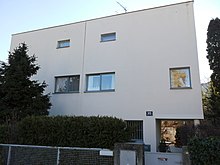Gabriel Guevrekian
Gabriel Guevrekian (* 1892 or 1900 in Constantinople , † October 29, 1970 in Antibes ) was an Armenian - American architect , landscape architect , designer and university professor .
Life
Gabriel Guevrekian was probably born in Constantinople in 1892 (according to a source also in 1900). He soon moved to Tehran with his Armenian family . In 1910 Guevrekian emigrated to Vienna , where he lived with an uncle. From 1915 to 1919 he studied at the Vienna School of Applied Arts with Oskar Strnad and Josef Frank . Until 1922 or 1923 he worked in Josef Hoffmann's studio and at Strnad. As early as 1920 Guevrekian was often in Paris and worked there with Robert Mallet-Stevens . Designs for gardens and villas in Paris and on the Côte d'Azur were created . From 1922 to 1926 he was a partner of Mallet-Stevens and lived in the French capital.
In 1926, Guevrekian started his own business as an architect, designer and garden architect. In 1928 he became general secretary of the CIAM . This is how he met Henri Sauvage , Le Corbusier , André Lurçat and Sigfried Giedion . In 1930 he was a founding member of the journal L'architecture d'aujourd'hui . In 1932 he planned a design for a double house for the exhibition of the Deutscher Werkbund in Vienna, the following year a design for the "Villa Kosrovani" in Tehran was created . He lived there until 1937 and was appointed city architect and planner of Tehran by the Shah. During his tenure there were significant new buildings for residential buildings, residences and several European-style government buildings.
From 1937 to 1940 he lived in London and Paris, from 1940 he settled again in Paris. From 1946 he was the architecture class leader at the “State School for Art and Crafts Saarbrücken” and worked intensively with Georges-Henri Pingusson . In 1948 he was appointed professor at the Alabama Polytechnic Institute in Auburn (USA), a year later he moved to the University of Illinois at Urbana-Champaign , where he taught architecture until 1969. In 1955 he became an American citizen.
Act
During his years in Vienna, Gabriel Guevrekian moved mainly around the Viennese school around Strnad, Frank and Hoffmann. The collaboration with Mallet-Stevens was also formative for him. He received further important suggestions from 1922 in Paris, where, through his work at CIEM, he found a connection with the group of functionalists around Le Corbusier, Lurçat and Giedion.
Guevrekian preferred to work with concrete and minimalist, geometric shapes. He achieved greater fame with the designs for Sonja Delaunay's Simultanée boutique and the cubist garden at the Exposition Internationale des Arts décoratifs et Industriels Modernes in Paris in 1925. His breakthrough came with a three-storey villa for the fashion designer Jacques Heim in Neuilly . From 1930 to 1932 Guevrekian participated with the semi-detached houses Woinovichgasse 10-12 in the Wiener Werkbundsiedlung project, which was looking for new alternatives in the field of social housing.
Buildings and gardens
- 1923: " Au Sacre du Printemps " business portal , 5, Rue du Cherche-Midi, Paris (not preserved)
- 1924: Interior design “Boutique Simultané”, Paris
- 1925: Cubist gardens for the Exposition Internationale des Arts Décoratifs et industriels modern , Paris
- 1927: Garden of the Villa Noailles , Hyères
- 1928: Villa Heim, 17, avenue des Madrid, Neuilly
- 1930–1932: Werkbundsiedlung double house, Woinovichgasse 10–12, Vienna
- 1933–1937: 20 private houses, residences and a theater in Tehran as well as the Iranian War Ministry, an officer's mess and the Ministry of Industry, Tehran
literature
- Hans J. Zechlin: Two French Architects. In: Wasmuth's monthly magazine for architecture and urban development . Vol. 14, H. 2, 1930, pp. 85-89, digitized .
- Elisabeth Vitou, Dominique Deshoulières, Hubert Jeanneau: Gabriel Guevrekian. 1900-1970. Une autre architecture modern. Connivences, Paris 1987, ISBN 2-86649-003-7 .
- Negar Hakim-Afyuni: Gabriel Guevrekian. An architect of international modernism in Tehran from 1933 to 1937. Diploma thesis at the University of Vienna, 2002.
Web links
- Gabriel Guevrekian in the Saar artists lexicon
- Guevrekian's estate in the University of Illinois Archives
Individual evidence
- ^ Gabriel Guevrekian in the Vienna Architects' Dictionary
- ↑ a b Guevrekian in the Encyclopaedia Iranica .
- ↑ A country house in Neuilly. By architect Gabriel Guevrekian . In: Interior Decoration, Vol. 40, 1929, pp. 296-310 ( digitized version ).
| personal data | |
|---|---|
| SURNAME | Guevrekian, Gabriel |
| BRIEF DESCRIPTION | Architect, horticultural architect, designer and university professor |
| DATE OF BIRTH | 1892 |
| PLACE OF BIRTH | Constantinople |
| DATE OF DEATH | October 29, 1970 |
| Place of death | Antibes |



